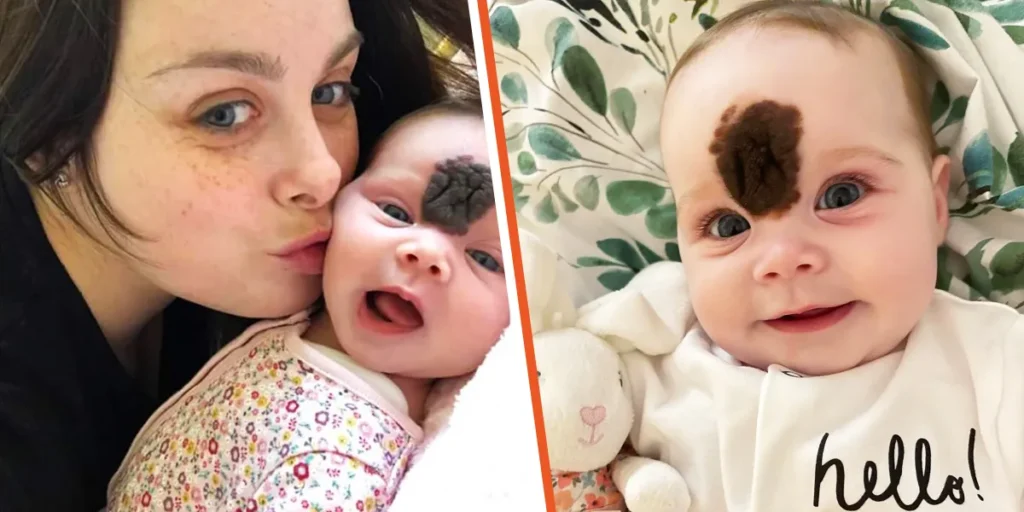A little girl was born with a strange birthmark that only affects one in every 20,000 babies. Her mother was worried that she had done something wrong and had no idea what the birthmark meant for her daughter. What she did know was that she wanted it removed.

Celine Casey, mother to Vienna Brookshaw, has shared the little girl’s incredible story. Casey and Brookshhaw, who live in the United Kingdom, began their journey in April 2021 when Brookshaw was born.
When doctors placed Brookshaw on Casey’s chest, Casey was immediately worried that she had done something wrong during her pregnancy, resulting in her daughter developing a pronounced birthmark between her eyebrows.Although the birthmark meant nothing for Brookshaw’s physical health, Casey knew the toll it might take on her mental health as she got older and encountered other children who would be curious about her condition.
What Was Vienna Brookshaw Born With?
Brookshaw was one of 20,000 babies born with congenital melanocytic nevus (CMN.) The condition means that Brookhaw was born with a cluster of benign pigment cells between her eyebrows that would have grown as she grew.
The condition is rare, and there was no way to tell how much Brookshaw’s birthmark may have grown as she got older. However, her mother knew she didn’t want her daughter to deal with that.Casey asked doctors to remove the birthmark as soon as possible so she wouldn’t grow up feeling different from all her peers. Casey also worried that if she didn’t remove the birthmark, her daughter would resent her and her partner. Casey shared:
“We love seeing her grow on her journey, and we can’t wait for the day that she does grow up and can speak for herself so we can hear her opinion, we’d love her no matter what, even if we did keep the birthmark.”
Although Casey wanted to remove the birthmark with only the best intentions, it was not easy for her. She even had to start a crowdfunding page so she could pay for her daughter’s surgery after being denied by the NHS.
How Did Casey Pay for the Surgery?
When Brookshaw was only an infant, Casey and her partner noticed that people were already staring at her and treating her differently from other babies, so they hid her face and knew they had to remove the birthmark as soon as possible
However, they were denied when the parents requested help from the NHS. The NHS will reportedly not pay for any surgery that is not essential for physical health. Brookshaw’s surgery might have been considered cosmetic and not crucial.
After learning they would not receive help from the NHS, Casey and her partner set up a GoFundMe page to raise the money they needed for their daughter’s surgery. They explained her situation and set a donation goal.In 24 hours, the parents had raised $52,000. However, the couple was hit with another blow when they learned that since the COVID-19 pandemic, hospital costs had skyrocketed, and they needed another $27,000.
They again used GoFundMe and raised all the money they needed for Brookshaw’s birthmark removal surgery. Casey shared:
“Everybody has things they’re insecure about on their body, and the doctor said he’d respect that, but with Vienna, it wasn’t going to affect her mental health right now. But we didn’t see it as that, she’s going to start school when she’s three, and younger kids are so smart, they point out stuff like that.”
Now, Brookshaw is two, and doctors have entirely removed her birthmark, leaving her with only a tiny scar between her eyebrows. Casey often shares updates about little Shaw’s scar and healing process on her social media, with followers telling Casey how “gorgeous” her little girl is.
Casey shared that although her birthmark had been removed, they still needed to travel to London so Brookshaw’s surgeon could assess how well her scar was healing and if she would need any further surgeries than the three she already had. Shaw is now living like a typical two-year-old.While little Brookshaw’s birthmark affected only a small area of her body, another little girl experienced birthmarks that covered 80% of her body.